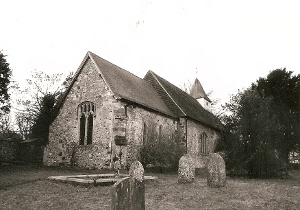Alciston – Dedication unknown
The nave and western chancel are C12. The chancel was altered in the C13 (it may then have been longer) and many windows were changed in the C15.
Alciston is at the end of a lane under the Downs. The manor was one of the largest in the original endowment of Battle abbey. Near the church is the partly C13 house, Alciston Court, with a dovecote and tithe-barn which are probably early C16 (4 p161). Remains of fishponds have been found (1 p97).
The north east quoin suggests that the aisleless nave is C12, though with later detail. It can be little older than the narrower chancel, which a round-headed north window shows is definitely C12. There is no chancel arch and no sign there ever was.
The chancel presents some puzzles. In the eastern part of the north wall are two lancets, their internal sills connected by a string-course. The south side has none, but an outline of a narrow pointed arch, too large for a doorway, may have led to a chapel that is unrecorded. Even if the south wall had been rebuilt, the chancel seems at first sight to conform to the pattern, common in Sussex, of a short C12 one lengthened in the C13. However, though long in proportion to the nave, a blocked third north east lancet (more visible inside) suggests it was once longer. Re-used dressed stones in the side walls also suggest rebuilding went beyond the replacement of windows. Excavations in 1984 (see 2) suggested the chancel reached its present size in the C15, the date of the present east window. Though the earlier foundations were hard to interpret, the original east end was thought to be apsidal (2 p97), a very unusual arrangement for the C13. The suggestion that the apse might be pre-Conquest (3) does not explain the C12 work in the north wall. Conceivably, the C12 chancel was abnormally long to allow use by the monks of Battle, though there were usually few in outlying manors.
C13 alterations to the nave included what looks like a lancet, only visible in outline outside, and a plain chamfered north doorway. A finely moulded and shafted C13 arch in the later north porch, though weathered, resembles some C13 work in the manor, though it may be slightly earlier and linked with Battle abbey. It was rescued ‘and reset from an adjacent building’ in 1861 (ICBS).
Despite the C13 remains, the present appearance is C15. There is evidence that the rebuilding of the side-walls may have followed a collapse of the east end (2 p96) – in addition, the string-course linking the sills of the north lancets breaks off before the third, blocked one. The C15 square east end has diagonal buttresses and a two-light window with panelled tracery and a segmental head. Only the mullions of this have been obviously replaced. A segment-headed south doorway and a cinquefoiled lowside may suggest that the presumed south chapel disappeared then. Though renewed, the windows of the nave are certainly C15; the north one has a depressed head and the west doorway has C15 mouldings. The lintel of the window above is wooden. The C15 moulded nave roof-timbers incorporate the belfry, resting on two braced posts against the walls.
Adelaide Tracy (1857) (IV p19) shows two square windows in the north nave, now vanished, which look C17. Other post-Reformation work includes the white boarding of the small belfry, which is present on the Sharpe Collection drawing (1803).
Repairs in 1841 (ICBS) and a restoration in 1853 (Harrison p16), which have left no obvious traces (possibly they in fact refer to the same work), preceded the main one in 1861. The ICBS file gives the detail for the last. As regards the nave for which the parish was responsible, the Society as an exception waived its customary stipulation that an architect undertook the work. This was because the main landowner in the parish refused any contribution, so money was short and the builder, T Cane of Brighton, drew up the plans. He replaced most external stonework and added the north porch, with its re-used arch. A passing remark in a letter from the vicar to the ICBS suggests that E Christian was restoring the chancel simultaneously. However, the chancel roof is variously dated to 1898 (Langdon p275) or 1896 (Meads), of which the latter is preferable since it is supported by a nearly contemporary source (KD/S 1899). Subsequent work has included the rebuilding of the porch in 1950 (Langdon ibid) and more recently the re-ordering of the chancel.
Fittings
Altar table: Heavy,with gothic detailing. It probably dates from the restoration of 1861. It is unusual to find a newly installed table at this date and even more so to find it still in use, unchanged.
Font: Plain octagonal and probably originally C15, though in the early C19 it is said to have born the date 1563 (Horsfield, Lewes II p15) (an unlikely date for a new font). Work costing £5 was done to it in 1861 (ICBS) and it is now C19 in appearance.
Mass dials: (Chancel south doorway) Five are to be seen.
Pulpit: Plain panelled sides that could be late C18 or earlier C19. It certainly predates either of the two later restorations.
Sources
1. H Clarke and P E Leach: The Mediaeval Churches of the Cuckmere Valley, SAC 123 (1985) pp95-108
2. P E Leach: Excavations at Alciston 1984, SAC 125 (1987) pp91-98
3. : Alciston – Preliminary Report, SAS Newsletter 44 (Dec 1984) p404
4. R T Mason: Alciston Court: a Manor House of Battle Abbey, SAC 116 (1977-78) pp159-62
Plans
1. Sketch plan of development of church in (2 p95)
2. Measured plan in 1 p98
My thanks to Nick Wiseman for the colour photographs.







